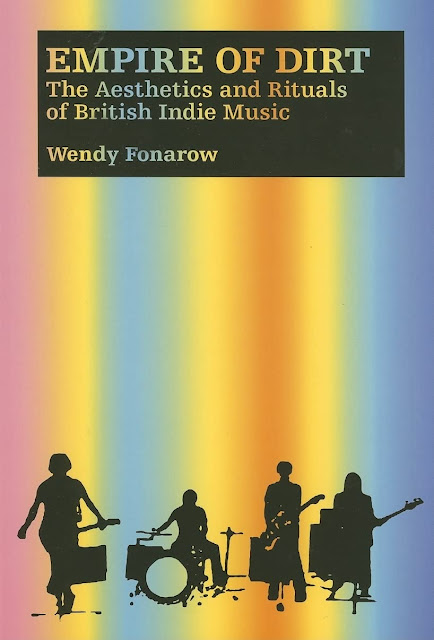Continuing from the previous post....
The title of Paul Stump's excellent book on prog rock The Music's All That Matters captures the idea expressed in the anti-punk letter to NME - - we don't put on a show, we leave that to commercial bands, we don't go in for image, we're all about the music and nothing but the music...
But then again, one of the things that prog bands, or some prog bands, explored was, well, showmanship: theatrics, costumes.... Jethro Tull and Gabriel-era Genesis being only two of the most glaring examples
There is a good bit in Philip Auslander's excellent, unusually-angled study Performing Glam Rock, where he contrasts the hairy Underground's gestural language onstage with glam performers. He talks about how your prog or blues-heavy or acid-jam type band would project inwardness - as if totally absorbed in making music. Minimal eye contact with the audience, no banter.... at times almost acting as if the audience wasn't there. Eyes closed. No strutting or guitar poses or even much moving about on the stage. A fairly static, concentrating-hard-on-the-job sort of stage presence. Distance maintained between rock-as-art and pop-as-entertainment.
Interestingly, Wendy Fonarow in her excellent anthropological study of British indie rock Empire of Dirt talks about "gaze strategies" - how bands similarly project inwardness, a "lost in music" aura, almost obliviousness to the audience's existence. This suggests that as much as it comes from shyness and from the need to look down at all those foot pedals, the gazing at shoes is an instinctive re-irruption of the Underground era approach of anti-performance.
Slowdive did talk about how they were more influenced by Pink Floyd than Sex Pistols.






Slowdive remains one of my most memorable concert-going experiences, and not in a good way. No, there certainly wasn't any theatricality, and if there was any "inwardness" to the band you'd have needed an X-ray machine to see it. They were complete ciphers. After a few songs I just stared in disbelief. Repetitive, minimalistic-- sure, like a leaky faucet.
ReplyDeleteI gather Slowdive may have released some good music, and to be fair they were the opening act and may not have had the right lighting or whatever to build their own atmosphere. But they were ruined for me ten minutes in. I'll never forget that show.
A variation on theatricality is when bands perform both the inwards and outwards on stage: the singer's prancing around in front and the bass player's standing to the side stock still, concentrating on his notes. That mix creates its own sort of dynamic spectacle. Probably lots of examples, but how about an easy one: Lydon off on his own script, the serious artist who sees through the nonsense; meanwhile Sid's lost in a daze, Paul and Steve bash around. Done right, mixing the theatrical and anti-theatrical creates some interesting dramatic effects.
Maybe if Rachel Goswell had flounced around the place like Cyndi Lauper while the other guys did their imitation of parking meters it would have worked...
Yes the one time I saw Slowdive live, which is around the first album, it was a pretty boring concert. Love the records, though, especially the Holding Our Breath EP.
DeleteReports from their shows last year say they were fantastic. This is coming from the new generation of Slowdive fans, though: they may want different things from a live show.
DeleteI know what you mean on Slowdive’s early shows. I also saw them in summer 91 at the ULU and it wasn’t very memorable but they certainly aren’t boring live nowadays. I’ve seen them three times since 2018 and all terrific shows. They came back as heroes at Primavera in 2014 and you can see on the footage how taken aback they were by the reception. I suppose the 21st century PA systems and lights etc. allowed a band like them to really flourish on stage. They can also rock out with the best of em now. That 2017 album might also be the best comeback record from any 90s act bar maybe Portishead’s ‘Third’. Their follow up to that in 2023 was also pretty excellent. Nice that it’s the same original five members still playing also.
DeletePink Floyd are a good reference point, because they essentially sidestepped it - first with the psychedelic light shows, then when they went out of fashion, with the projected films and the surrounding stage business (model planes, giant balloons, paper-box walls). A deliberate attempt to draw the audience's focus away from them and their lack of stage presence (indeed, at the beginning of the Wall shows they were able to send out a 'surrogate band' wearing rubber masks of their faces)
ReplyDeleteThe 60s/early 70s light shows are often forgotten or written off as extracurricular in retrospective histories, which is a shame, because they're the missing piece in many ways as to how psychedelia developed as it did, and why bands were able to feel like they should focus on the music and let the stage tend to itself
The other element is that, early on, psychedelic shows were dances - that was often the main reaction of older observers like Ralph Gleason (who said it was the return of swing-era audiences) and Bo Diddley (who stopped early on during his first appearance at the Family Dog and said 'you're dancers! I haven't played for dancers in a long time' before switching up his setlist)
DeleteI recall one of the weeklies once labelling earnest activist Aussie outfit Midnight Oil ("Beds Are Burning" was their biggest international hit) "rock's least glamorous band". It was meant as an insult, but they'd take it as a compliment.
ReplyDeleteYet Midnight Oil's appearance - their image - seems to speak volumes about their ethos and essence. In a weird way there's no getting away from "glam" - clothes are always rhetoric, and so is a shaven head.
Delete